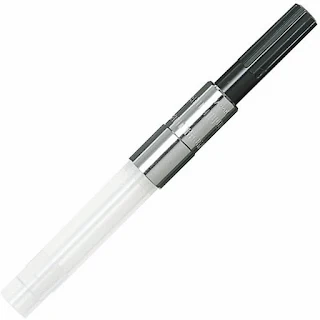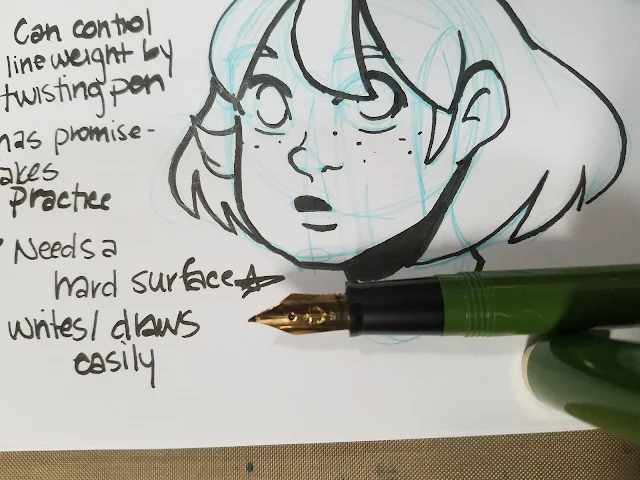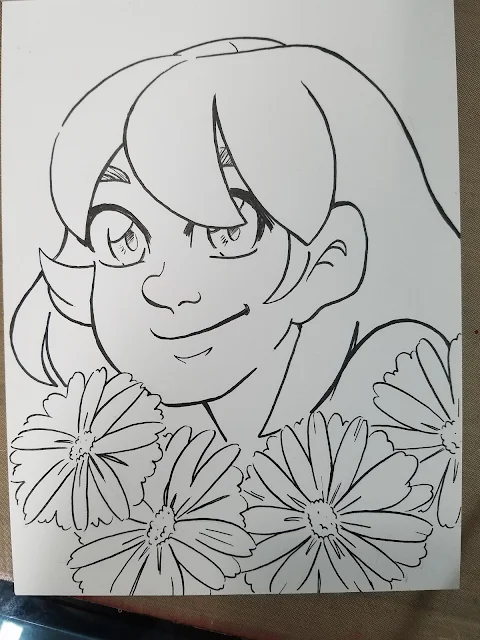Inking and Lettering with Fountain Pens
I assure you guys, I have no intention of this blog becoming a fountain pen blog. There are plenty enough of those. I don't even intend to do full reviews of the pens I've purchased, unless one is particularly standout, or one just outright fails.
I did, however, buy a few after visiting with Heidi and recording a video on the best fountain pens for sketching. I was weak- playing around with dip nibs for Inktober made me fall in love with nib inking again- and I wanted to find the Pentel Pocket Brush equivilent of a fountain pen. Something inexpensive, with expressive lines, that I could take anywhere. Heidi's reccs started me off on a strong foot- the TWSBI Eco and a JetPens Chibi for fun, but I quickly added a Noodlers Flex, a Pilot Varsity, and a Sailor Fude De Mannen.
You can check out our guide video AND the shownotes by clicking here.
Pens Purchased:
TWSBI Eco (piston type reservoir)
JetPens Chibi (and converter)
Noodler's Flex (piston type reservoir)
Pilot Varsity (disposable, for general writing and maybe doodling)
Sailor Fude De Mannen (and converter)
TWSBI Eco
Jetpens Chibi
Noodler's Flex
Pilot Varsity
Sailor Fude De Mannen
Sailor's Fude De Mannen have nibs with varying degrees. The above pen (as well as mine) has a 55 degree angle. I would be interested in trying the 40 degree Fude de Mannen as well.
I couldn't play with my new toys until an appropriate ink was found and I quickly ordered Platinum's Carbon Ink, also by Heidi's recommendation.
Ink Purchased
Platinum Carbon Ink
Cleaning My New Toys:
Used the method demonstrated on Withoutink
Setting Up My Pens
After cleaning, all three pens were easy to use on the Rhodia blank pad I picked up at Paper and Ink Arts. Instant ink startup, no skips, no catching on the paper. I found that the Noodler's Flex, although a bit stinky, handled the best for what I wanted, and was able to sketch and doodle without nipping the paper. The Pentel Chibi also handled quite well, almost as well as the Flex, and the TWSBI offers a broader nib with a little less flex. All three are great so far, and have been inked up with my Carbon Ink.
The TWSBI and Flex both have their own pistons for easy filling, but I purchased a little converter for my Pentel Chibi.
I think I'm going to add my Flex to my everyday art carry, but the Chibi and TWSBI ECO will probably live on my desk, at least until I ink the Chibi with something exciting (or order another).
Sailor Fude De Mannen
After I'd already cleaned out my Flex, TWSBI, and Chibi, my anticipated Fude de Mannen arrived from Amazon.
A fude style fountain pen is designed to facilitate Eastern style characters and replicate the stroke of a brush. Instead of being more flexible than Western nibs, a fude style nib is bent at an angle (45 or 55) to facilitate this.
Drawing with Fountain Pens
Noodler's Flex and Fude De Mannen
Drawn in a Rhodia Blank notebook.
Noodler's Flex
Fude de Mannen
TWSBI Eco and Jetpens Chibi
Sketched on Rhodia blank paper.
Jetpens Chibi
TWSBI Eco
Inked with the TWSBI Eco and the Noodler's Flex
Sketched and inked on Strathmore 400 series Mixed Media paper with Platinum Carbon Ink using a TWSBI Eco and a Noodler's Flex.
Daisies were inked with the Noodler's flex, as it can deliver a fine line. I noticed no paper tearing.
Outlines and major details were inked with a TWSBI Eco broad nib.
Finer details were inked with a combination of the TWSBI and the Noodler's Flex.
Ink was allowed to dry for 24 hours, then erased, with no noticeable ghosting.
When sketching and inking, I find myself reaching for the Noodler's Flex, especially after listening to Goulet Pens interview with Nathan Tardif. It's such an easy little pen to ink with- a good amount of flex, doesn't nip up quality watercolor paper, easy to get started, doesn't require much pressure to with. Right now, if you're interested in a fountain pen for inking your art, I definitely recommend it.
Pros of using a Fountain Pen to Ink
Comic Lettering with a Fountain Pen
Although I lettered alphabets with all four of my fountain pens, only the Fude De Mannen had a distinctive stroke. This makes sense as it's a pen designed to replicate stroke calligraphy.
This said, the TWSBI Eco is enjoyable for general writing, and I find myself reaching for it when I want to make notes.
Outside Resources:
Fountain Pen Network: Painting With Watercolors over a Fountain Pen
Jetpens Blog: Fountain Pens (section)
Parts of a Fountain Pen
Fountain Pen Terminology
Pen Maintenance
Filling Mechanisms
Fast Pen Flushing
How to Write with a Flex Nib
Fast Pen Flushing
How to Write with a Flex Nib
If you enjoyed this post, there are loads of ways you can let me know! You can shoot me an email using the form in the lefthand sidebar, you can share this post to your social networks using the sharing buttons below, you can link this post on your favorite forums and sites. These are all great ways to show me that you enjoy my content, as you're helping me increase my audience, spread the goodness of art education to the masses, and helping me establish legitimacy. If you'd like to show more support, contacting companies on my behalf is a great way to really help me in a meaningful way- you can find company info in the righthand sidebar. If you'd like to help fund future posts, you can purchase something from my online shop or my Gumroad shop. Finally, if you'd like to join my community of art nerds, gain early access to content, AND help support future posts, head on over to my Patreon for information on how to join the community.
I did, however, buy a few after visiting with Heidi and recording a video on the best fountain pens for sketching. I was weak- playing around with dip nibs for Inktober made me fall in love with nib inking again- and I wanted to find the Pentel Pocket Brush equivilent of a fountain pen. Something inexpensive, with expressive lines, that I could take anywhere. Heidi's reccs started me off on a strong foot- the TWSBI Eco and a JetPens Chibi for fun, but I quickly added a Noodlers Flex, a Pilot Varsity, and a Sailor Fude De Mannen.
You can check out our guide video AND the shownotes by clicking here.
Pens Purchased:
TWSBI Eco (piston type reservoir)
JetPens Chibi (and converter)
Noodler's Flex (piston type reservoir)
Pilot Varsity (disposable, for general writing and maybe doodling)
Sailor Fude De Mannen (and converter)
TWSBI Eco
 |
| TWSBI Eco. Image Source |
 |
| TWSBI Eco Image Source |
Jetpens Chibi
 |
| Jetpens Chibi Image Source |
 |
| Monteverde Mini Fountain Pen Converter Image Source |
 |
| Noodler's Flex Image Source |
 |
| Noodler's Flex Image Source |
Pilot Varsity
 |
| Pilot Varsity Image Source |
 |
| Pilot Varsity Image Source |
Sailor Fude De Mannen
 |
| Sailor Fude De Mannen Image Source |
Sailor's Fude De Mannen have nibs with varying degrees. The above pen (as well as mine) has a 55 degree angle. I would be interested in trying the 40 degree Fude de Mannen as well.
 |
| Sailor Piston Converter Image Source |
 |
| Sailor Piston Converter Image Source |
I couldn't play with my new toys until an appropriate ink was found and I quickly ordered Platinum's Carbon Ink, also by Heidi's recommendation.
Ink Purchased
Platinum Carbon Ink
Cleaning My New Toys:
Used the method demonstrated on Withoutink
Setting Up My Pens
After cleaning, all three pens were easy to use on the Rhodia blank pad I picked up at Paper and Ink Arts. Instant ink startup, no skips, no catching on the paper. I found that the Noodler's Flex, although a bit stinky, handled the best for what I wanted, and was able to sketch and doodle without nipping the paper. The Pentel Chibi also handled quite well, almost as well as the Flex, and the TWSBI offers a broader nib with a little less flex. All three are great so far, and have been inked up with my Carbon Ink.
The TWSBI and Flex both have their own pistons for easy filling, but I purchased a little converter for my Pentel Chibi.
I think I'm going to add my Flex to my everyday art carry, but the Chibi and TWSBI ECO will probably live on my desk, at least until I ink the Chibi with something exciting (or order another).
Sailor Fude De Mannen
After I'd already cleaned out my Flex, TWSBI, and Chibi, my anticipated Fude de Mannen arrived from Amazon.
A fude style fountain pen is designed to facilitate Eastern style characters and replicate the stroke of a brush. Instead of being more flexible than Western nibs, a fude style nib is bent at an angle (45 or 55) to facilitate this.
Drawing with Fountain Pens
Noodler's Flex and Fude De Mannen
Drawn in a Rhodia Blank notebook.
Noodler's Flex
Fude de Mannen
TWSBI Eco and Jetpens Chibi
Sketched on Rhodia blank paper.
Jetpens Chibi
TWSBI Eco
Inked with the TWSBI Eco and the Noodler's Flex
Sketched and inked on Strathmore 400 series Mixed Media paper with Platinum Carbon Ink using a TWSBI Eco and a Noodler's Flex.
Daisies were inked with the Noodler's flex, as it can deliver a fine line. I noticed no paper tearing.
Outlines and major details were inked with a TWSBI Eco broad nib.
Finer details were inked with a combination of the TWSBI and the Noodler's Flex.
Ink was allowed to dry for 24 hours, then erased, with no noticeable ghosting.
When sketching and inking, I find myself reaching for the Noodler's Flex, especially after listening to Goulet Pens interview with Nathan Tardif. It's such an easy little pen to ink with- a good amount of flex, doesn't nip up quality watercolor paper, easy to get started, doesn't require much pressure to with. Right now, if you're interested in a fountain pen for inking your art, I definitely recommend it.
Pros of using a Fountain Pen to Ink
- Can use a wide variety of inks and ink colors- from very watersoluble to waterfast, to inks with dichromatic properties
- Inexpensive options like the Jetpens Chibi, Pilot Preppy, and the Pilot Petit1 can be purchased in quality and filled with a rainbow of colors, if you enjoy colored linework
- Even without flex, with an italic nib, you can achieve a lot of lineweight by rotating the pen slightly.
- The most flexible nibs on an unmodded, stock pen will be on vintage pens, which tend to be expensive
- If you want to carry a lot of ink, you may need to buy a converter or try an eyedropper conversion
- Need to be careful about the papers you ink on- sketchbook paper is generally a no go, but tightly woven papers and coated papers should work decently
- Unless you mod or buy a modded pen, no nib will deliver the flex of a flexible dip pen nib
- Can't use just any inks- need to use exclusively fountain pen inks, otherwise ink may clog/ruin pen
Comic Lettering with a Fountain Pen
 |
| Uppercase alphabet lettered with the Sailor Fude de Mannen, lettered on Strathmore Writing paper (prelined) |
Although I lettered alphabets with all four of my fountain pens, only the Fude De Mannen had a distinctive stroke. This makes sense as it's a pen designed to replicate stroke calligraphy.
This said, the TWSBI Eco is enjoyable for general writing, and I find myself reaching for it when I want to make notes.
Outside Resources:
Fountain Pen Network: Painting With Watercolors over a Fountain Pen
Jetpens Blog: Fountain Pens (section)
Parts of a Fountain Pen
Fountain Pen Terminology
Pen Maintenance
Filling Mechanisms
Fast Pen Flushing
How to Write with a Flex Nib
Fast Pen Flushing
How to Write with a Flex Nib
If you enjoyed this post, there are loads of ways you can let me know! You can shoot me an email using the form in the lefthand sidebar, you can share this post to your social networks using the sharing buttons below, you can link this post on your favorite forums and sites. These are all great ways to show me that you enjoy my content, as you're helping me increase my audience, spread the goodness of art education to the masses, and helping me establish legitimacy. If you'd like to show more support, contacting companies on my behalf is a great way to really help me in a meaningful way- you can find company info in the righthand sidebar. If you'd like to help fund future posts, you can purchase something from my online shop or my Gumroad shop. Finally, if you'd like to join my community of art nerds, gain early access to content, AND help support future posts, head on over to my Patreon for information on how to join the community.



















Comments
Post a Comment